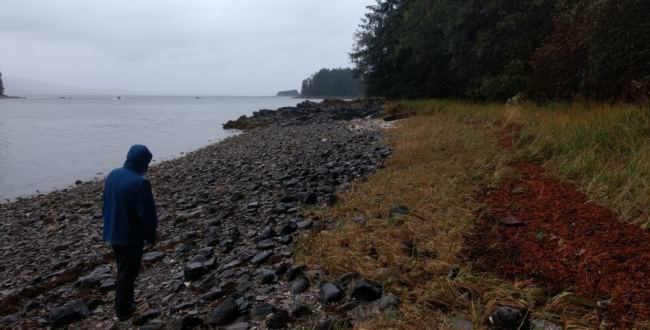
Indian Point, a former Tlingit village site on Auke Bay, may be ceded to a nonprofit dedicated to Aak’w Kwáan heritage.
The land was controversially acquired by the federal government before ending up in municipal hands in the 1960s.
At the southern-most point of Auke Cape, a rocky outcropping offers sweeping views of Indian Cove and Indian Island. Auke Cape is commonly known as Indian Point. These names give away this area’s history.
“This is a south-facing, waterfront lot with beautiful views of Auke Bay,” Greg Chaney, lands manager for the City and Borough of Juneau, said. “Which is the exactly the reason that the Native people selected it for their village site so many centuries ago.”
The cape’s southern tip has been city-owned since the 1960s. It picked up a third tract in a three-way swap in the 1990s and now holds most of the cape and is looking to return it to the descendants of its original inhabitants.

“It’s very much like finding a wallet that somebody has – you pick it up on the street and you think, ‘Oh, this belongs to somebody,’” Chaney said. “And so then, you know, I think most people would agree the proper thing to do is to return it to the rightful owners.”
Randy Wanamaker, a former Juneau Assemblyman wrote to the Assembly last month recommending that the city give Indian Point to the Goldbelt Heritage Foundation. The 73-year-old recalls spending time there as a boy with his grandfather who was born on Auke Bay.
“We used to put branches in the water for the herring eggs and dip nets in the water and get the herring out,” Wanamaker said by telephone from Seattle where he now lives. “That was a practice that was going on for thousands of years, but it got wiped out by the commercial fisheries.”
Goldbelt Heritage shouldn’t be confused with its sister organization Goldbelt Inc., a for-profit Native corporation. The nonprofit’s mission is cultural stewardship.
“They do a lot of things that honor and respect the culture and history of the original inhabitants,” Wanamaker said.
The story of how Indian Point became government land is typical of what happened to many Native villages across Alaska.
By the 1920s, much of the Native population around Auke Bay had moved to Juneau and Douglas to work in the mines, though they would periodically return to Auke Bay to hunt, fish and gather food.
“They were practicing a lifestyle that was in balance with nature. But the Forest Service in Southeast Alaska always said it was not used and it had been abandoned and that would be their justification when they acquired it for the federal government,” Wanamaker said. “The federal government did not consult with the Alaska Native people when they dispossessed them of their land. They just took it away.
As recently as 2002 in the Forest Service’s official history in Alaska asserts that Auke Bay villages were abandoned.
Anthropologist Tom Thornton, investigated the cultural value of Indian Point on behalf of the federal government in the 1990s, said it wasn’t so simple.
“There was sort of a larger campaign to move Native people off of the Tongass forest land, and burning cabins and things like that. And the Forest Service always denied that until they stopped denying it and then apologized for it,” Thornton said in an interview from the University of Oxford where he’s a professor.
Thornton’s research helped get Indian Point listed last year on the National Register of Historic Places.
The Forest Service first acknowledged in 2008 that it had wrongly removed fish camps and smokehouses, vital for the subsistence lifestyle, in the early 20th century.
Tongass National Forest spokesman Paul Robbins Jr. said in a statement that the Forest Service acknowledges that the destruction wasn’t limited to fish camps.
“As we continue our dialog with the Aak’w Kwáan and various other tribes in this region, the Forest Service is going to remain open to all new information as historians continue to delve into the storied past of Southeast Alaska.”
The 52 acres on Indian Point is perhaps the most valuable — in real estate terms — that the city owns.
“That’s why we have to be very careful about transferring it to an organization that’s going to look out for the cultural interests of the Aak’w Kwáan and not just look at it as a multi-million dollar asset,” Chaney said. “In our current generation, we have the opportunity to right a wrong that was done generations ago. This was the old village site, this was a sacred site, and we could return it to the Aak’w people in our time.”
Indian Point was almost cut up in the 1960s for a housing subdivision. Opposition by the Alaska Native Brotherhood and others put a stop to that.
A half-century later, the possible fate of Indian Point again lies with the Juneau Assembly.
The lands committee is slated to consider the transfer later at its Oct. 23 meeting.
Jacob Resneck is CoastAlaska's regional news director in Juneau.




